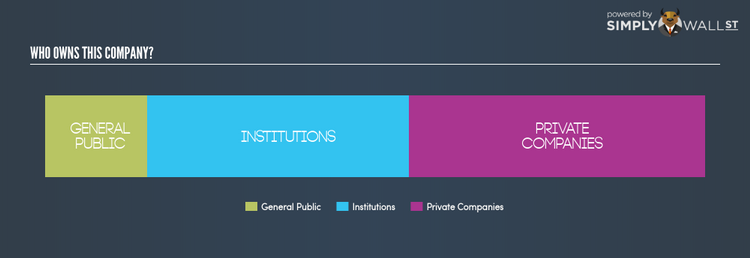Should You Be Concerned About China Vanadium Titano-Magnetite Mining Company Limited’s (HKG:893) Investors?

In this article, I’m going to take a look at China Vanadium Titano-Magnetite Mining Company Limited’s (SEHK:893) latest ownership structure, a non-fundamental factor which is important, but remains a less discussed subject among investors. Ownership structure of a company has been found to affect share performance over time. Differences in ownership structure of companies can have a profound effect on how management’s incentives are aligned with shareholder returns, which is why we’ll take a moment to analyse 893’s shareholder registry.
See our latest analysis for China Vanadium Titano-Magnetite Mining
Institutional Ownership
Institutions account for 39.64% of 893’s outstanding shares, a significant enough holding to move stock prices if they start buying and selling in large quantities, especially when there are relatively small amounts of shares available on the market to trade. Although 893 has a high institutional ownership, such stock moves, in the short-term, are more commonly linked to a particular type of active institutional investors – hedge funds. For 893 shareholders, the potential of this type of share price volatility shouldn’t be as concerning as hedge fund ownership is is not significant,indicating few chances of such sudden price moves. While that hardly seems concerning, I will explore further into 893’s ownership type to find out how it can affect the company’s investment profile.
General Public Ownership
A substantial ownership of 15.60% in 893 is held by the general public. With this size of ownership, retail investors can collectively play a role in major company policies that affect shareholders returns, including executive remuneration and the appointment of directors. They can also exercise the power to decline an acquisition or merger that may not improve profitability.
Private Company Ownership
Another important group of owners for potential investors in 893 are private companies that hold a stake of 44.76% in 893. These are companies that are mainly invested due to their strategic interests or are incentivized by reaping capital gains on investments their shareholdings. An ownership of this size indicates a strong financial backing and has the potential to influence 893’s business strategy. Thus, investors should dig deeper into 893’s business relations with these companies and how it can affect shareholder returns in the long-term.
Next Steps:
The company’s high institutional ownership makes margin of safety a very important consideration to existing investors since long bull and bear trends often emerge when these big-ticket investors see a change in long-term potential of the company. This will allow investors to reduce the impact of non-fundamental factors, such as volatile block trading impact on their portfolio value. However, ownership structure should not be the only focus of your research when constructing an investment thesis around 893. Instead, you should be evaluating company-specific factors such as China Vanadium Titano-Magnetite Mining’s past track record and financial health. I highly recommend you to complete your research by taking a look at the following:
1. Financial Health: Is 893’s operations financially sustainable? Balance sheets can be hard to analyze, which is why we’ve done it for you. Check out our financial health checks here.
2. Past Track Record: Has 893 been consistently performing well irrespective of the ups and downs in the market? Go into more detail in the past performance analysis and take a look at the free visual representations of 893’s historicals for more clarity.
3. Other High-Performing Stocks: Are there other stocks that provide better prospects with proven track records? Explore our free list of these great stocks here.
NB: Figures in this article are calculated using data from the last twelve months, which refer to the 12-month period ending on the last date of the month the financial statement is dated. This may not be consistent with full year annual report figures.
To help readers see pass the short term volatility of the financial market, we aim to bring you a long-term focused research analysis purely driven by fundamental data. Note that our analysis does not factor in the latest price sensitive company announcements.
The author is an independent contributor and at the time of publication had no position in the stocks mentioned.

